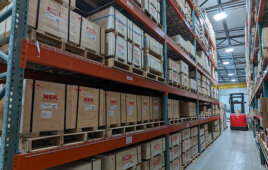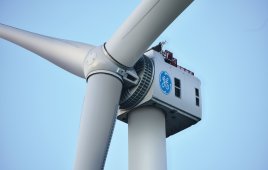
The pump unit for the Timken’s Wind Energy Lubrication System holds about eight liters of grease.
Due to long, continuous operations, wind turbine main-shaft bearings need consistent, reliable lubrication. Timken’s Wind Energy Lubrication System addresses such needs with a single pump, in two models capable of working with either series-progressive or injector-based lubricant delivery methods. Timken says the HP pump model provides continuous lubrication with a conventional method of pressure purging old grease. An LP version uses an active-purge system that removes old grease without internal bearing-cavity pressure.
Timken says a rugged and versatile pump is at the heart of both units. They feature powerful pump performance for consistent delivery of grease up to NLGI No. 2 and excellent “cold climate” pumping properties. An offset piston element reduces side loading, while increasing pump life from a standard 24 Vdc power connection (115/230 Vac is optional). CPC and DIN style power-connection are options. An 8-liter standard grease reservoir allows once-yearly turbine maintenance with stirring paddle and wiper to minimize air pockets and grease separation.
Three fill ports simplify lubricant refilling when mounted in tight areas. Advanced flow elements reduce stagnant grease flow to the pump inlet. In a conventional method of grease movement, fresh grease is pushed into the cavity. It finds a path of least resistance around accumulations of old grease. This allows inadequate replenishment of grease in one of the bearing rows.

An active purge system removes old grease mechanically and by suction at the exit side of each bearing row for freer grease movement. Minimal amounts of fresh grease are directed to each row, providing positive replenishment and assuring that neither row is starved for lubrication.
The lubrication units also sport a clever and patented charger, which mechanically charges old grease into an orifice where it can be removed by suction. The ability to remove grease without cavity pressure improves seal function because it provides optimum lubrication.
Knowing how much and how often lubricant can be introduced to critical bearing contact areas is a primary challenge to obtaining proper lubrication of any bearing. Common practice in a two-row bearing is to provide a single grease-injection inlet between the two bearing rows. Over time, this can cause uneven lubrication in each row due to aged grease accumulating near the inlet. Accumulation then forces fresh grease to a path of least resistance, potentially starving grease to one of the bearing rows. The LP lubricator addresses the issue with a low-pressure centralized-lubrication system that directs grease to inlets and uses an active purging method to reliably lubricate bearings. The system’s central pump delivers lubricant through a supply line to multiple banks of injectors. When used with tapered roller bearings, each injector bank operates independently to lubricate each bearing row at the small end of the roller. Lubricant naturally pumps to the large-roller end where the grease is then “charged” into outlet ports and suction elements powered by the grease pump, which pull old grease to a waste container.
Timken Co.
www.timken.com
Filed Under: Bearings, Lubricants




